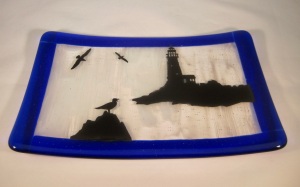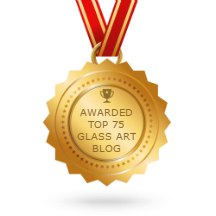I have long wanted to try glass combing. I actually bought the combing rod at a Glass Convention probably in like 2012. But some projects always seem to get pushed to the back burner especially if they include any uncertainty as did glass combing.
For good reason, there are many warnings with glass combing are you are opening the kiln when it is at a very high temperature and as we all know, hot glass can be dangerous. I had read the warnings on Glass Campus about wearing welding jacket or similar protective gear and I didn’t have this. And basically is all sounded scary.
Then one day I decided to just go for it. I have opened my kilns before when they are hot to check on a pot melt or whatever and it wasn’t that bad.
To get prepared, I got out:
* welding gloves
* welding sleeves (borrowed from my husband)
* glasses with UV protection
* all cotton clothes
* Fitbit removed
* hair pulled back in a pony tail
* rake or comb
* bucket of water to cool the rake
First attempt
I wasn’t sure if I was supposed to use a solid piece on the bottom, so chose white and then other colors for the top including black. I laid the white on the shelf and then 3/8” strips on end on top, all dammed of course. It took a very long time for the kiln to heat to 1638 degrees and while I read to wait till it got to 1650 degrees, I gave up, opened the kiln and did one pull. I was afraid to do more than one pull in case it cooled a lot.
I could hear the glass crackling the entire time which was a little disconcerting but since I wasn’t sure what was normal, I hoped for the best.
Since the kiln had cooled to about 1550 degrees, I had to wait for it to heat back up to 1638ish for another pull. This took at least another hour.
Just so you don’t need to wait for the punch line on temperature, let’s do an aside here. My kiln is probably not the best for this task. It is a glass kiln whose top temperature is 1700 degrees with the elements in the lid which I am lifting and letting a lot of heat out. I have learned since then that better kilns are those where you can drop the shelf or clamshell-like where the heat stays in the lid as you expose the bottom and so a reheat to the top temperature should only take 10-15 minutes. Another reason mine is bad is that because it takes so long to get to that top temperature, the glass is hot for a very long time which is not a good thing.
In the end, after doing 3 pulls, cooling and annealing for a very long time (4 hours to be on the safe side) and a slow ramp down to cool, I opened the kiln. The glass was in many pieces. I asked for advice on several Facebook groups, but most couldn’t tell me what was wrong. My pictures looked okay. I have read that whites can be finicky and I had a lot of white including the entire bottom sheet.

Second Attempt
For my second attempt, I did not put a sheet on the bottom under the strips and used a lot more transparent colors of glass. The rest of the process was the same as above as I couldn’t change anything about the kiln. In this case, it did not crack and the pulling was okay although I realized I should have pulled more to have a more visible pull. However, in this one, you can see in the picture how the glass merged together and there is a sheen of green transparent across almost the whole top, sort of like it was more viscous and so flowed more.
I also learned that I can be very heavy handed and put a scratch in my shelf by taking the rake too deep.
I just took a class from Janine Stillman of Designs by J9 and learned that because of my long heat times, her phrase was that “it gobbles as it floats to the top and takes over the top.” So I lose some of the colors and the definition.
I was ecstatic though that it did not crack and I actually got it to a finished piece that a customer loved.


Third Attempt
I decided to go with blues for this attempt and because of the green transparent taking over in the 2nd attempt, I used less clear. And for this one I got impatient and tried the pull closed to 1600 and you can see in the center pull how it stuck to my rake and left thin lines of glass as I pulled the rake out. It made an interesting affect for the blue as almost looked like a jelly fish but of course was not planned and probably not really a good thing for combing. You can also see more definition in the blues.

Fourth Attempt
Then life got in the way and it was almost 2 years before I was able to try again recently. I was inspired by a rainbow picture where I could clearly see clear between the colors and wanted to try this. So I did another lay up, but since I didn’t take good notes, I used a sheet of clear on the bottom. I also can’t find a picture of my lay up, but for the strips, it was one strip color, one strip clear and so on. I didn’t quite get it to look like the inspiration picture as again the colors merged together more but each one I do is getting better.
In addition, I thought I had gotten some reactions going between colors which I really did not want, but it also could have just been overheating some of the colors. Not sure on this one.

Photo Credit: Jerry Schneider
I am writing this as I sit at the annual Glass Convention in Las Vegas and having just taken the class from Janine.
So what are my lessons learned:
1) I don’t need a bucket of water, just a bowl and instead should be more willing to dip the rake into the water before doing a pull.
2) You get different effects when you push versus pull, so I have to keep that in mind in my design.
3) As mentioned above, my kiln is not ideal as I cannot access my kiln from all four side and if I want to keep doing this, I might try a different kiln.
4) Clear glass is great to use and adds more visual interest.
5) Don’t be afraid to work smaller and use as a part sheet. Again who knew! What a great idea!
6) It doesn’t matter if you use a full sheet below or not as long as you have 1/2” depth, so make strips wider if no sheet below.
I am so glad I tried this technique and also that I took Janine’s class and I can’t wait to get home and try some different things to see what other pieces I can make.















